
For the online entrepreneur, earning income from one or more websites is a requirement. Whether you’re writing about something you’re passionate about, or working to help other people, it’s the monetization of that effort that allows you to continue and prosper.
That would explain why there are so many articles written about how to monetize your website and content. What a surprise!
Here’s the thing: many of the most effective monetization methods revolve around trading hours for dollars. You sell your time in the form of services or products.
Either way, each sale involves some amount of time to conceive, develop, produce, market and support. We refer to these models as “active.” The more you sell, the more of your time they take. The upside is that they pay better than most “passive” models.
Speaking of “passive”…
The most popular passive income methods, like Google AdSense or Amazon Affiliate links, tend to have extremely poor payouts.
Other ad networks and affiliate programs with new twists on an old idea may promise better pay, but incremental improvements on low pay don’t add up to much.
This article delivers not one, but two pieces of good news…
First, there are lesser-known, emerging methods and tools you can use to passively monetize your search and social driven traffic.
Second, you don’t have to limit yourself to just one! These passive monetization methods play very well together.
So, let’s explore some of the best paying, passive monetization models that you most likely have never heard of.
1. AfterOffers
You’ve no doubt been told how important it is to invite readers of your content to sign up for your email list. And if you’ve been diligent about it, you’ve likely created some interesting offers to entice your prospective subscriber, perhaps even some content upgrades.
And that’s great! That’s exactly what you should be doing to build up your email list so that you can communicate with subscribers and nurture them into real, live paying customers.
But what happens immediately after someone subscribes? If you’re like most of us, you probably show them a nice Thank You page that lets them know how much you appreciate their interest, and reminds them to check their Inbox for your confirmation email.
What if, just before you send them to your great Thank You page, you could suggest to them a few other email subscription offers they might be interested in?
They’ve already said Yes once, so they’re primed to say Yes again to a similar request that isn’t asking too much.
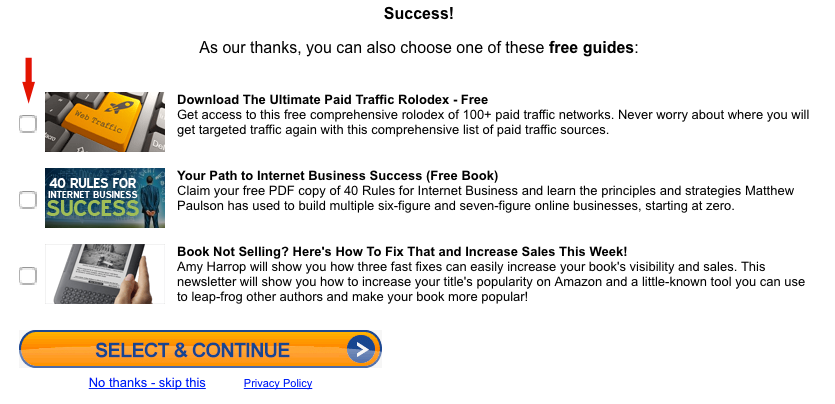
That’s where AfterOffers comes in.
Once you sign up, it’s relatively easy to get started. You’ll provide AfterOffers with the URL for your Thank You page, and they’ll provide you with a different confirmation URL to plug into your signup process.
Let’s say, for example, that you’re using MailChimp to invite subscribers to sign up for your newsletter. And you’re using one of MailChimp’s embedded forms to grab their email address and first name.
First, you’ll create a Thank You page within your own site (if you haven’t already). Next, provide that page’s URL to AfterOffers. Once someone sees the recommended offers, whether they accept them or click on the Skip This link, they’ll be redirected to your Thank You page as normal.
Second, you’ll take the URL provided by AfterOffers, go into MailChimp, and edit the “Signup thank you page” form to use that address, like this:
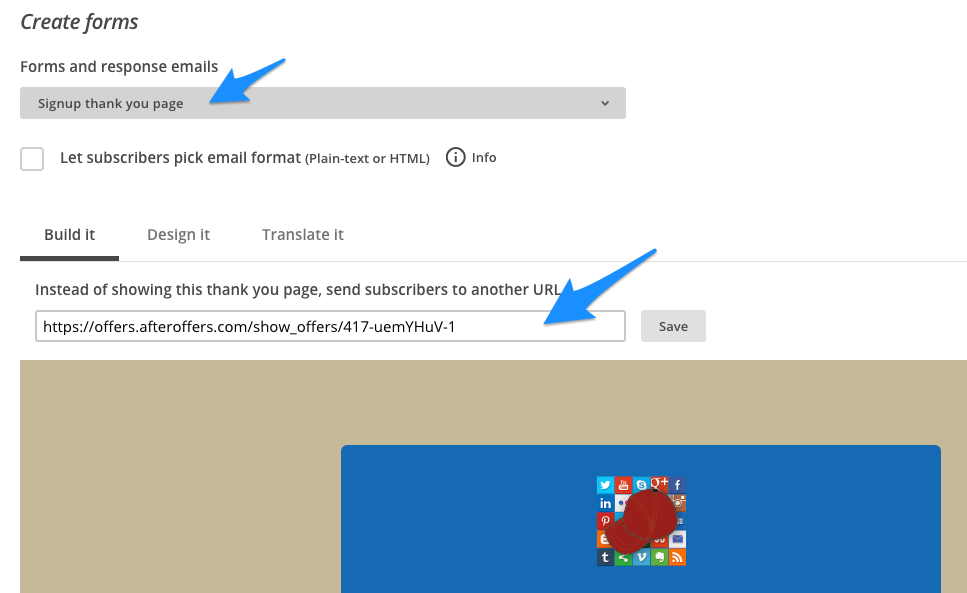
It works the same way with SumoMe and most other email subscription services.
Once everything is set up, you’ll begin to get weekly payments depending on how many subscribers you drive through to the new offers. The more email signups you get per day overall, the more visibility and clicks those offers will receive.
It’s an effective way to add more passive monetization to your existing email marketing efforts. And the payment is an extra incentive to grow your list. Round it goes!
EFFORT: Low
POTENTIAL: Medium (“Free Bonus Income”)
2. SkimLinks
Let’s head over to your site’s content and talk about affiliate relationships and affiliate links.
Affiliate sales in and of themselves can be a good source of revenue for bloggers — and are often the primary source of revenue.
But let’s face it, affiliate earnings are limited to the relationships that we set up and the content that we create around those products and services.
If I’m going to earn money from, say, AgoraPulse, that means I must become an AgoraPulse affiliate, create content for and about AgoraPulse, and insert affiliate links accordingly.
In short, I pretty much have to love AgoraPulse. And I do.
But do you have to do that for each and every brand that you mention on your site? Nope.
That’s where Skimlinks comes in.
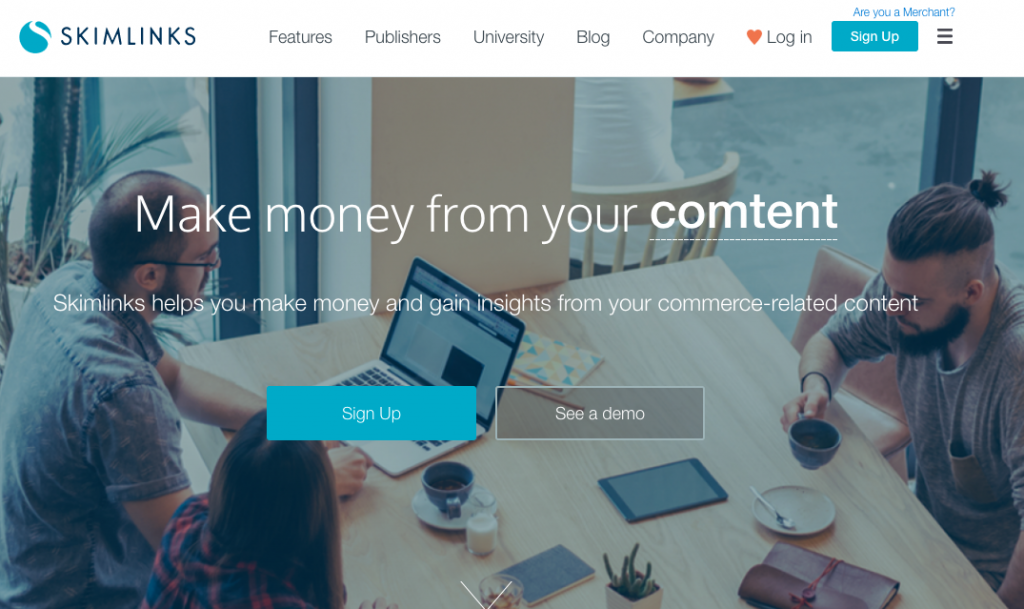
Skimlinks automatically reviews your new and existing content and makes your previously unlinked brand mentions clickable and affiliated using relationships that Skimlinks creates.
In other words, you have the potential to create affiliate revenue from brands that you don’t already have an affiliate relationship with and just happen to mention on your site.
Now, to be fair, it’s far less likely that a casual mention of a brand within a lengthy article is going to drive as much traffic and interest as a post that’s all about a specific tool or service.
Your success and profitability with Skimlinks will depend in large part on the volume of content you’ve created, and how often you mention other brands.
That said, it’s super easy to put Skimlinks in place and test how well your site will perform.
Once you sign up, Skimlinks will provide you with a simple script that you’ll embed into the header of your website so that it’s called whenever any page loads. Monitor performance each day within the Skimlinks hub and see for yourself.
EFFORT: Low
POTENTIAL: Low (But Near-Zero Extra Effort)
3. Disqus Reveal
I know many bloggers have eschewed comments in recent years, turning instead to discussion and commentary on social media. We may be old school, but we like having a comment system on our blog.
Our blog comments are a source of questions and inspiration. And readers appreciate being able to post their thoughts right on the content.
With that in mind, we’ve been doing a lot of testing recently of a new monetization option from Disqus called Reveal.
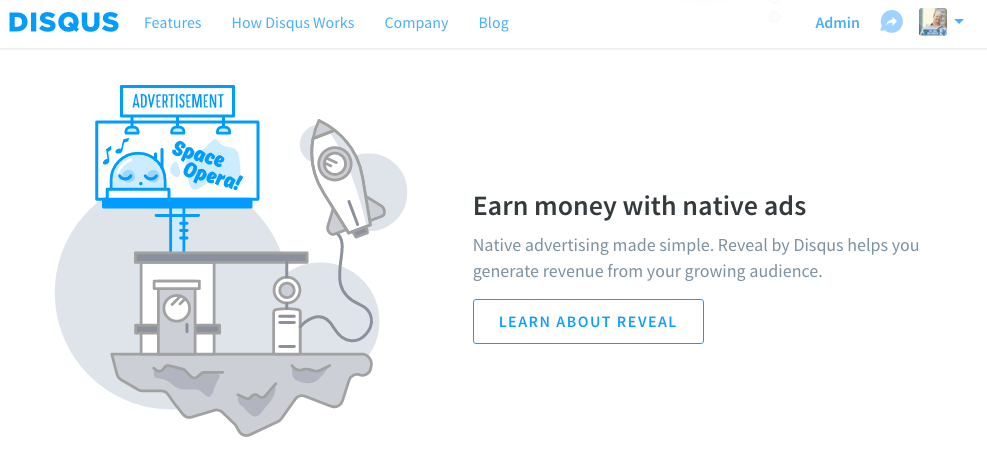
Disqus is one of the most common commenting systems in use, outside of native options (such as WordPress comments). If you aren’t already using Disqus, installing the plugin or module is relatively easy (though if you’ve been using an alternate system for some time, do look into how past comments can be migrated).
With the system in place, Reveal acts as an additional content discovery engine for your readers. As they scroll down your page and finish reading your article, Disqus presents them with other stories and articles they might be interested in from other sites. You earn revenue when your visitors click to those stories.
Once you have Disqus installed, activating Reveal is as simple as turning it on within the Revenue settings of your Disqus account. You can make minor adjustments to the appearance and location, as well as check to make sure the category you’ve chosen for your website is the most appropriate one.
Keep in mind that Disqus will be displaying stories based on that category, so it’s important.
Once set up, monitor it on a daily/weekly/monthly basis to keep an eye on earnings and ensure that it’s having a positive impact for you.
EFFORT: Low (but you are monetizing an un-monetized frontier)
POTENTIAL: Low – Medium
4. Shareaholic
This behaves along the same lines as Disqus Reveal. If you’re using the Shareaholic social sharing widget, you can choose to display additional related content.
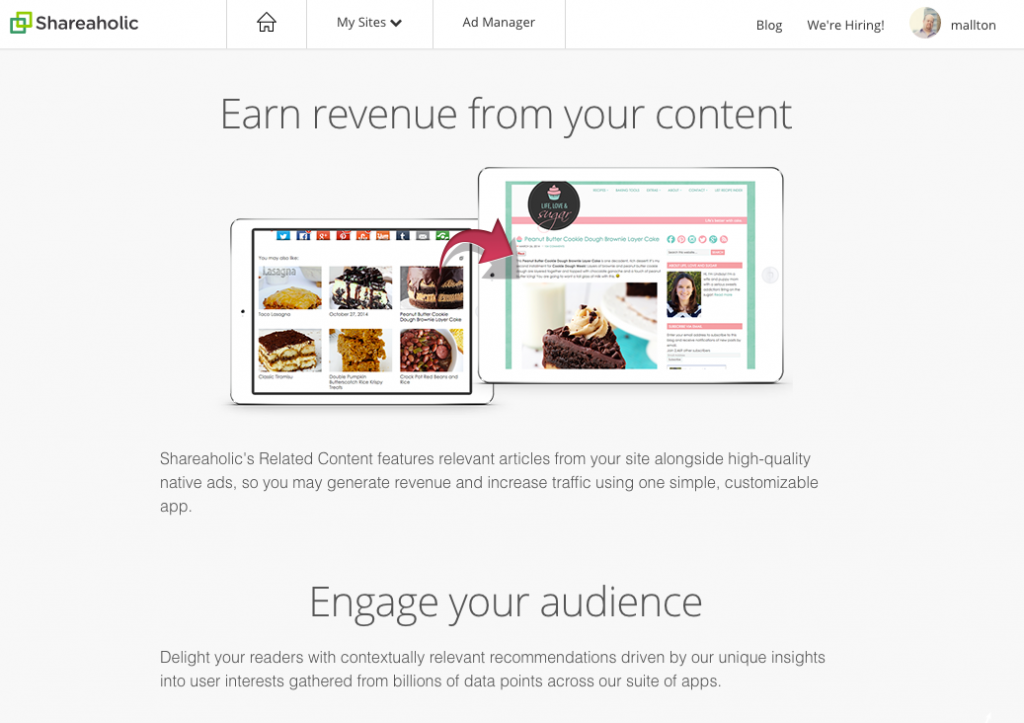
One of the things that we like about Shareaholic’s take is that you can include both your own content and advertisers’ content in the recommendations, and can adjust the sliding scale to suit your needs.
If you’re using Shareaholic for its primary function of social sharing, you already have the plugin installed for that purpose. All you have to do is enable the monetization option and configure it.
Depending on your installation, you may need to specify a location for the “Related Content” widget to appear. That’s a nice feature since you can test different placements and discover where your readers notice the stories more.
You can modify the style of story presentation, the number of stories, and whether a full ad is displayed below them.
As with Disqus, review your settings and confirm that the category you’ve chosen for your website is accurate.
Pro Tip: Regularly review the ads that are being displayed on your website for appropriateness, just as you would for Google AdSense. Avoid using any monetization method that results in inappropriate ads or content that’s so unrelated to what your audience is interested in that they’ll just ignore the recommendations.
EFFORT: Low
POTENTIAL: Low – Medium
5. Google AdSense Inline Ads
Stay with us. This isn’t the Google AdSense that I’ve mentioned a couple of times now and each time it’s been with the suggestion that AdSense isn’t usually very profitable. And that’s for good reason.
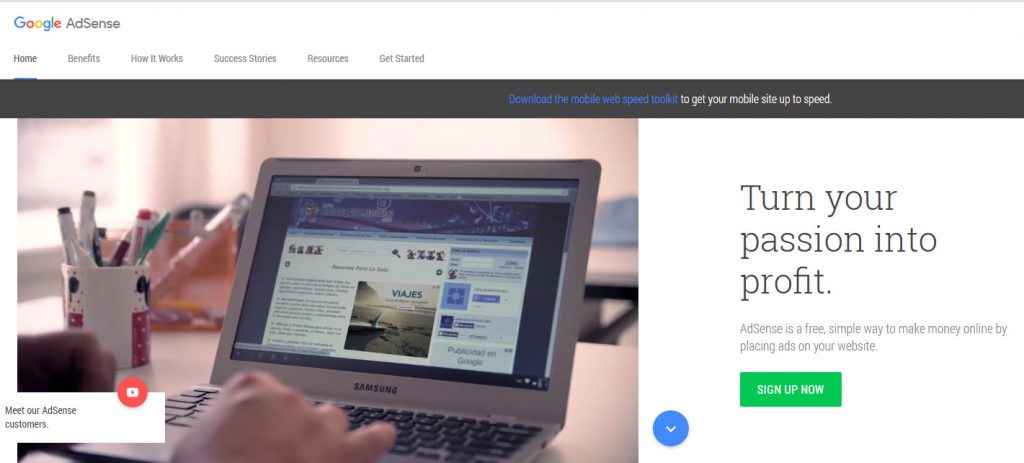
Most of us experiment with AdSense ad placements in the typical website locations like banner ads above and below content, and skyscraper ads in one or more sidebars.
The problem is, that’s exactly where your readers expect you to have ads! They’re conditioned to expect ads in those locations and can therefore easily ignore them.
What if, instead of using a predictable location, we put ads directly within the content of the article itself?
These are called inline ads. You may have seen them in major publications.
While I’m not advocating inserting an ad unit between every paragraph of content like some clickbait publications do (especially now that Google has removed the 3-units-per-page restriction), the fact is, inline placement is the most lucrative advertising position you can use.
The problem is that AdSense cannot put those ads there for you. You’re going to have to work a little bit to implement this passive monetization technique.
First, you’ll need to create a new ad unit in your AdSense account. Select the Responsive Ad type so that the placed ads will adjust with your content and the device that’s viewing the page.
Copy the embed code provided by AdSense (click on Get code and copy the HTML snippet) and embed it within your content.
The problem with the code approach is that you need to be comfortable enough with HTML markup to be able to insert the code in the correct spot within your post, plus the fact that it’s a manual insertion into each post.
If code gives you wet palms, you can automatically inject that ad code into your content, usually after the first or second paragraph.,,
- WordPress users: Download and install the Insert Post Ads plugin.
- Drupal users: Download and install the Block Inject module.
Once you’ve installed and configured the dynamic ad placement capability, you’ll be able to view and monitor your new inline ad placement’s performance.
I think you’ll find these ads outperform all other passive monetization models that you’re running.
EFFORT: Medium
POTENTIAL: Medium – High
6. Newstex
Finally, if you’re creating content that’s within the realm of technology, law or political science, you might consider syndicating it to ACI (formerly known as Newstex).
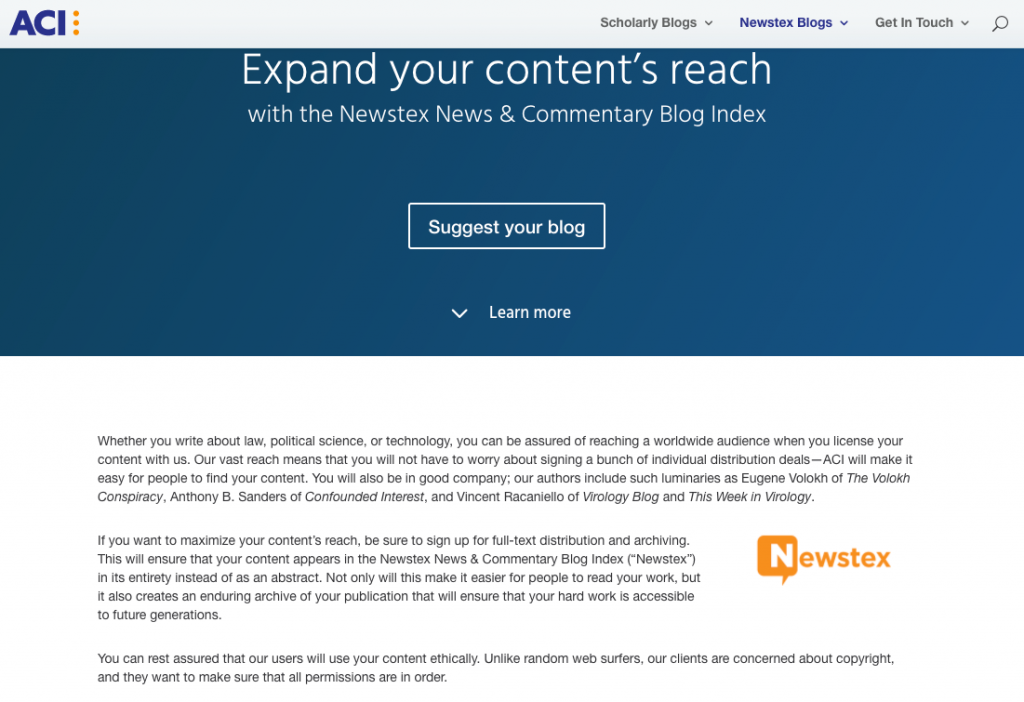
Newstex can automatically pull in your new content and then, in turn, distribute it to other publications like NewsCred, LexisNexis and others.
Earnings will vary wildly, as they depend on the views of your content, but that means they’re also somewhat under your control. The more quality content that you publish, the more you can syndicate and make available to these paying publishers.
If your niche falls outside those general topics, you may find other paid destinations to syndicate your posts, like ScribbleLive.
EFFORT: Variable
POTENTIAL: Low
Wrapping Up
One of the threads woven throughout all of these techniques is that of creativity. It’s easy to add a few AdSense ads or Amazon affiliate links to your blog, but it takes creativity to come up with passive monetization methods that will earn you a decent income.
And let me be clear: it also takes some hard work. Of course, doesn’t outstanding content deserve more than copy-and-paste ads and links?
Creating a content-rich site is not easy. It cannot be done overnight. Virtually every monetization technique, particularly passive ones, require high levels of traffic landing on outstanding pieces of content. Creating that content is something you’ll need to commit to. (It’s part of our C![]() T
T![]() P
P![]() M process, taught as part of Solo Build It!)
M process, taught as part of Solo Build It!)
You can and should test all of these techniques. And without a doubt, most of them, individually, are not likely to yield dramatic income levels. But if you combine several of them together, like AfterOffers + Inline Ads, you may find your blog and business with a very respectable passive revenue stream.

Latest posts by Mike Allton (see all)
- How to Avoid Failure in an Entrepreneurial Business - September 23, 2019
- How to Use Buffer for Social Media Management: The Solopreneur’s Guide - September 15, 2019
- Wix Review: An In-Depth Comparison of 10,000 Websites - September 1, 2019

